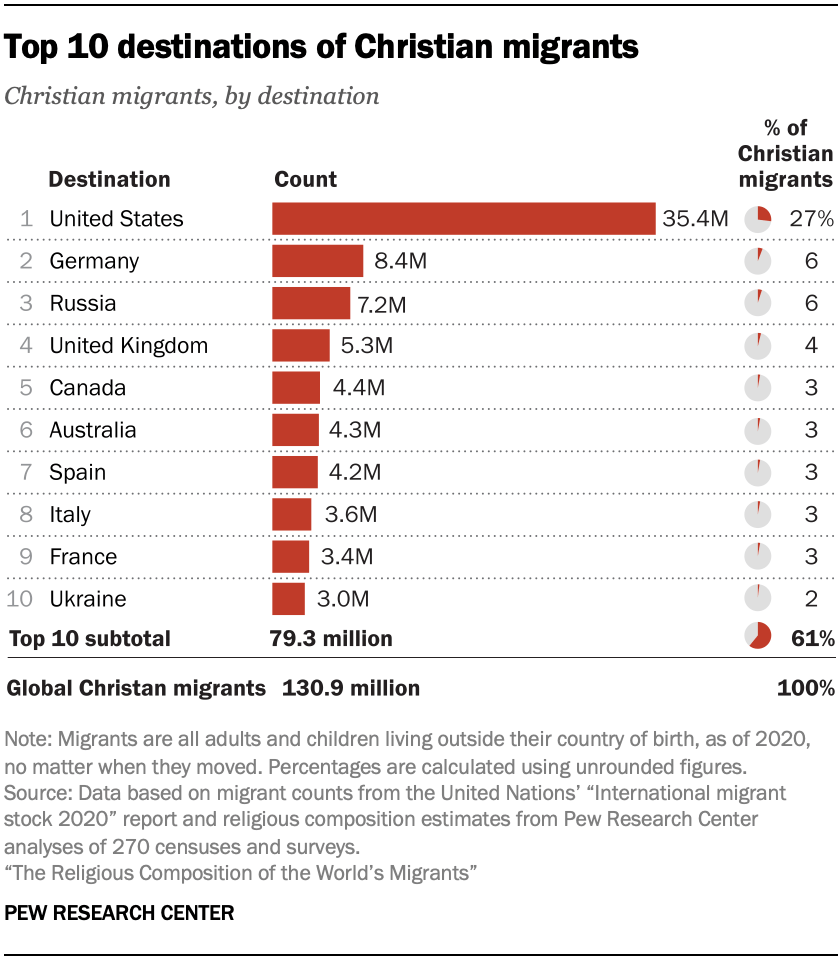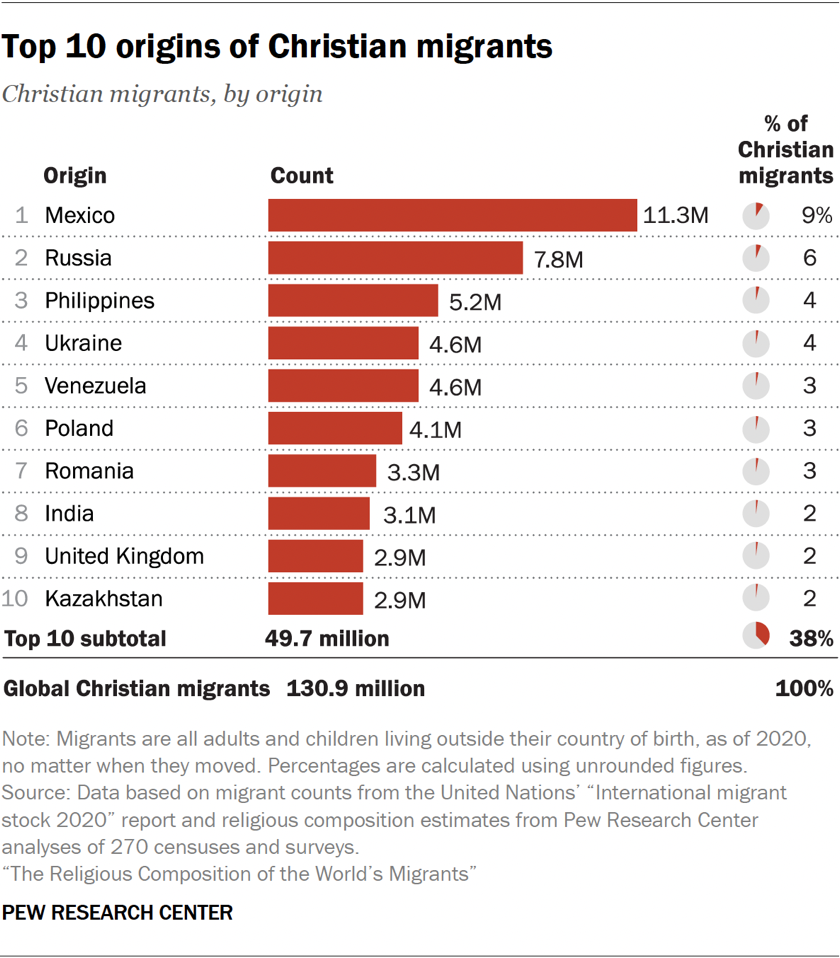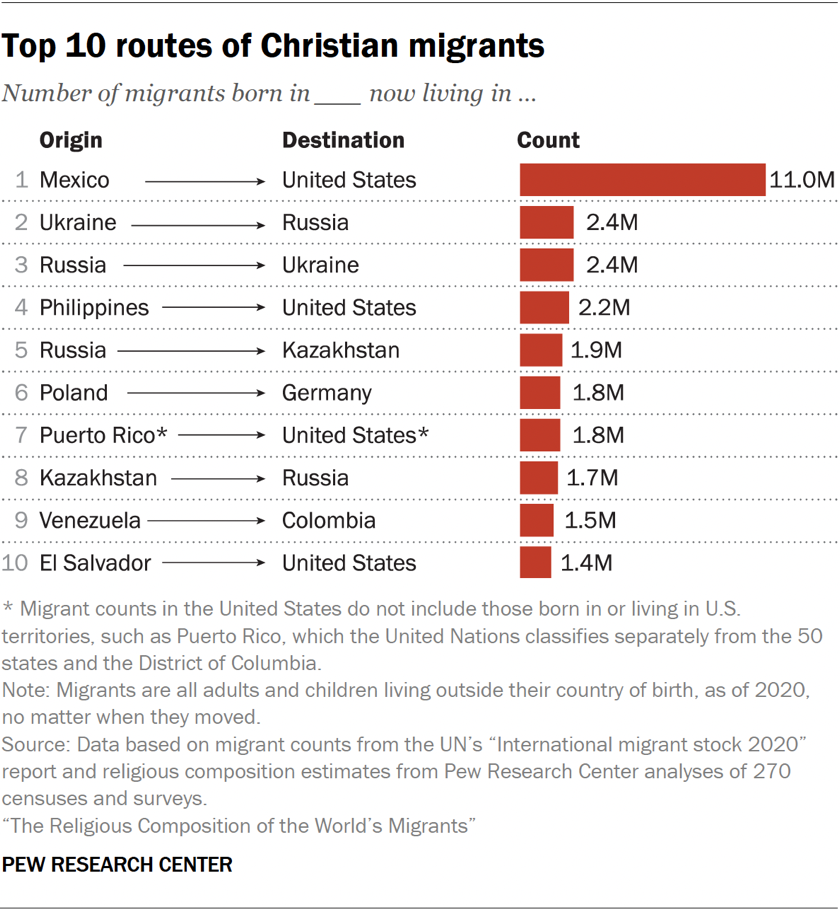World
3. Christian migrants around the world

The United Nations counts international migrants as people of any age who live outside their country (or in some cases, territory) of birth – regardless of their motives for migrating, their length of residence or their legal status.
In addition to naturalized citizens and permanent residents, the UN’s international migrant numbers include asylum-seekers and refugees, as well as people without official residence documents. The UN also includes some people who live in a country temporarily – like some students and guest workers – but it does not include short-term visitors like tourists, nor does it typically include military forces deployed abroad.
For brevity, this report refers to international migrants simply as migrants. Occasionally, we use the term immigrants to differentiate migrants living in a destination country from emigrants who have left an origin country. Every person who is living outside of his or her country of birth is all three – a migrant, an immigrant and an emigrant.
The analysis in this report focuses on existing stocks of international migrants – all people who now live outside their birth country, no matter when they left. We do not estimate migration flows – how many people move across borders in any single year.
Christians are the largest religious group in the world among both migrants and nonmigrants. They are overrepresented among international migrants, accounting for 30% of the world’s overall population and 47% of all people living outside their country of birth, as of 2020.
Christian migrants have traveled an average of 2,400 miles from their origin to destination countries – roughly the same distance as Buddhists, Jews and the religiously unaffiliated.
Most of the world’s 131 million Christian migrants live in Europe (37%) or North America (30%). About 10% are in the Asia-Pacific region, followed by a little over 9% each in the Latin America-Caribbean and sub-Saharan Africa regions. Only 4% of Christian migrants live in the Middle East and North Africa.
Europe is the most common place of origin for Christian migrants (35%), followed by Latin America and the Caribbean (30%). Fewer Christian migrants originated from a country in the Asia-Pacific region (17%) or sub-Saharan Africa (13%). About 2% of all Christian migrants were born in North America, and 2% were born in the Middle East-North Africa region.
Destinations
Christians tend to move to countries that already have large Christian populations, and four of their top 10 destinations are predominantly English-speaking countries. Like other religious groups, Christians often migrate to wealthy nations in search of economic opportunities.

The United States is home to a larger total population of international migrants than any other country, including an estimated 27% (or 35.4 million) of the world’s Christian migrants.
Germany is the second-most common destination for foreign-born Christians, hosting about 6% of them (8.4 million). Like the U.S., Germany has a large native-born Christian population and a huge, dynamic economy. The most common origin of Christian migrants in Germany is Poland (1.8 million). Other Christian migrants to Germany often come from within the European region or from Kazakhstan.
As of 2020, Russia was the third-most popular destination country for Christian migrants, home to 7.2 million. Christian migrants to Russia tend to come from nearby countries like Ukraine, Kazakhstan and Uzbekistan.
Russia has historically been better off economically than many surrounding nations, and it drew migrants from these places even before the dissolution of the Soviet Union in 1991.
Origins
With some exceptions, Christian migrants tend to come from countries that have Christian majorities and weaker economies than their neighbors.

Mexico is the most common country of origin for Christian migrants (11.3 million), accounting for 9% of the world’s Christian migrants. The majority of Christian migrants from Mexico have moved to the U.S., typically looking for jobs, improved safety or to reunite with family members who migrated earlier.
Russia is the second-most common birth country for Christian migrants (7.8 million). Christians from Russia have tended to move to nearby countries like Ukraine, Kazakhstan and Germany for work or to reunite with family.
The Philippines is the third-most common origin country for Christian migrants (5.2 million). Filipinos have often left the country to seek economic opportunities or due to political instability.
Perhaps surprisingly, India is another common source of Christian migrants, with over 3 million originating from there. Christians are a tiny minority in India, but given the large size of the country’s population, there are tens of millions of India-born Christians.
Moreover, India is one of many countries in which emigrants disproportionately come from a religious minority. Christians make up 2% of India’s population but an estimated 16% of all the people who were born in India and now reside elsewhere.
Country pairs
By far the most common pathway for Christian migrants is from Mexico to the U.S. More than 11 million Christians have taken this route. As of 2020, about 8% of the world’s stock of Christian migrants was born in Mexico and now lives in the U.S.

Bidirectional movement between Ukraine and Russia has also been common for Christians, with 2.4 million having moved in each direction as of 2020. Historically, people have often moved between these two countries for work, education and family reunification.
More than 2 million Christians born in the Philippines now reside in the U.S., making this the fourth-most common path for Christian migrants globally.
Change since 1990
The total number of Christian migrants grew from 73 million in 1990 to more than 131 million in 2020 (up 80%). Christian migrants increased a little less than migrants as a whole, who grew in number by 83% over the same period.
The U.S., Germany and Spain have seen the largest rises in Christian migrants.
In the U.S., the Christian migrant stock more than doubled from 16.9 million in 1990 to 35.4 million in 2020, partly due to a surge of migrants from Mexico, the Philippines and Guatemala.
Germany saw its Christian migrant population grow from 2.8 million to 8.4 million (up 198%). Many arrived from Poland, Kazakhstan and Russia – countries where communist regimes collapsed starting in 1989, prompting mass outflows of people to wealthier Western Europe.
In Spain, the Christian migrant population jumped from fewer than 500,000 to almost 4.2 million over this timespan (up 865%). Most of this growth came from Latin America and the Caribbean, as financial crises in Colombia, Ecuador and Venezuela triggered recessions and caused millions of people to seek jobs elsewhere. Spain became a top destination for migrants from this region, due to a shared language and Spain’s newfound economic success as a fledgling member of the European Union.
However, the single most-common source of migrants to Spain in 2020 was Romania, which went through years of upheaval after its repressive government collapsed with the fall of the Soviet Union, leading to an exodus of Romanians to countries with more stability. The stock of Romanian Christian migrants living in Spain surged from 2,000 in 1990 to 550,000 in 2020, an increase of more than 28,000%.
On the other hand, the number of foreign-born Christians living in Ukraine fell from 4.3 million in 1990 to 3.0 million in 2020 (down 30%), and the count in Malawi dropped from 990,000 in 1990 to 170,000 (down 83%). These decreases are partly due to return migration, especially in Malawi, where large numbers of Christians from neighboring Mozambique returned after that country’s civil war ended. Shrinking Christian migrant populations in these countries are also due to deaths among earlier waves of migrants.
By origin, the largest increase in Christian migrants came from Mexico, which accounted for 4.7 million Christian migrants in 1990 versus 11.3 million in 2020 (up 139%). The vast majority of these migrants made their way to the U.S. Some migration was due to unintended consequences of the North American Free Trade Agreement, which took effect in 1994 and contributed to wide-scale unemployment for Mexican farmers. After 2006, net migration from Mexico to the U.S. stalled and then reversed, as more migrants returned to Mexico than arrived from there.
The next-largest surge came from Venezuela, which was the origin of only 160,000 Christian migrants in 1990 versus 4.6 million as of 2020, an increase of about 2,800%. Nearly all of the increase in migration out of Venezuela has occurred since 2015, when there were an estimated 550,000 Venezuelan Christians living outside their country of birth. Many have left Venezuela due to soaring inflation, political instability and escalating violence, and the flow of Venezuelans out of the country continued after 2020.
The source countries with the steepest declines of Christian migrants were Russia, which accounted for 9.3 million emigrants in 1990 and 7.8 million in 2020 (down 15%), and Mozambique, which went from 1.9 million to 600,000 over the same period (a 68% decline). In both places, economic and political turmoil gave way to more stability, inviting return migration. Additionally, some migrants who left Russia and Mozambique before 1990 have since reached the end of their lives.
Refer to our “Geographic spotlights” section for in-depth analyses of migration in Europe and the United States.






:focal(0x0:3000x2000)/static.texastribune.org/media/files/9f9df5d8e38e56397be7f883cd61490a/1230%20Migrant%20Workers%20SB%20TT%2009.jpg)

